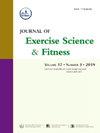老年人身体健康相关因素和人群差异:一项横断面研究。
IF 2.4
2区 医学
Q2 SPORT SCIENCES
引用次数: 0
摘要
目的:利用中国全国体质监测调查的数据,探讨老年人体质的相关因素及其在人群中的差异。研究设计:横断面研究。方法:共有13524名年龄在60-79岁的老年人参与了这项研究。参与者完成了身体健康评估,包括体脂率、肺活量、高抬腿、握力、坐姿前屈、30秒坐立测试、闭眼单腿站立和选择反应时间。通过特征提取、标签设计和主成分分析和k-原型聚类,构建了轮廓分析模型。采用有序probit回归对体质相关因素进行分析,并采用自举法评估组内差异。结果:根据聚类结果将老年人分为4类(第一类:n = 2728人,第二类:n = 6067人,第三类:n = 4189人,第四类:n = 540人)。结果表明,中高强度体力活动与老年人的身体健康水平有显著正相关关系(α = 0.001, p α = 0.003, p α = 0.001, p α = 0.002, p α = -0.089, p α = -0.002, p)。应根据不同人群鼓励参加体育活动和锻炼,以进行精确和定量的干预,以改善体质。本文章由计算机程序翻译,如有差异,请以英文原文为准。
Factors associated with physical fitness and disparities in population segments among older adults: A cross-sectional study
Objectives
This study aimed to investigate the factors associated with physical fitness and disparities in population segments among older adults, using data from the National Physical Fitness Surveilling Survey of China.
Study design
A cross-sectional study.
Methods
A total of 13524 older adults aged 60–79 years were involved in the study. Participants completed physical fitness assessments encompassing body fat percentage, lung capacity, high leg raise in place, grip strength, seated forward bending, 30-s sit-to-stand test, single-leg standing with eyes closed, and choice reaction time. A profile analysis model was constructed by feature extraction, label design and clustering using principal component analysis and k-prototypes. Factors associated with physical fitness were analyzed using ordered probit regression, and within-group differences were evaluated through the bootstrap method.
Results
The older adults were categorized into four clusters based on the clustering results (Cluster I: n = 2728, Cluster II: n = 6067, Cluster III: n = 4189, Cluster IV: n = 540). Significant positive associations were identified between moderate-to-vigorous transport-related activities = 0.001, p < 0.05), moderate-to-vigorous household chores ( = 0.003, p < 0.01), work-related physical activity ( = 0.001, p < 0.01), exercise ( = 0.002, p < 0.01) and physical fitness levels. Conversely, the number of illnesses ( = -0.089, p < 0.01) and sedentary behavior ( = -0.002, p < 0.05) were negatively associated with physical fitness. Inflection points were observed, indicating shifts from lower level to higher physical fitness levels as the volume of diverse moderate-to-vigorous physical activities increased. Disparities in factors associated with physical fitness were identified across the different clusters. The associations of household chores, transport-related activities, and work-related physical activity with physical fitness lacked robustness during heterogeneity processing. In contrast, exercise consistently demonstrated a facilitating role across all clusters. Furthermore, greater marginal effects on achieving higher physical fitness test scores were observed among individuals classified as inactive when engaging in more moderate-to-vigorous activities and exercise.
Conclusion
The findings demonstrate that engagement in moderate-to-vigorous physical activities and exercise is associated with a significantly higher probability of achieving better physical fitness among older adults. Participating in physical activities and exercise should be encouraged based on population segments for precise and quantitative interventions to improve physical fitness.
求助全文
通过发布文献求助,成功后即可免费获取论文全文。
去求助
来源期刊
CiteScore
5.10
自引率
3.60%
发文量
54
审稿时长
31 days
期刊介绍:
The Journal of Exercise Science and Fitness is the official peer-reviewed journal of The Society of Chinese Scholars on Exercise Physiology and Fitness (SCSEPF), the Physical Fitness Association of Hong Kong, China (HKPFA), and the Hong Kong Association of Sports Medicine and Sports Science (HKASMSS). It is published twice a year, in June and December, by Elsevier.
The Journal accepts original investigations, comprehensive reviews, case studies and short communications on current topics in exercise science, physical fitness and physical education.

 求助内容:
求助内容: 应助结果提醒方式:
应助结果提醒方式:


